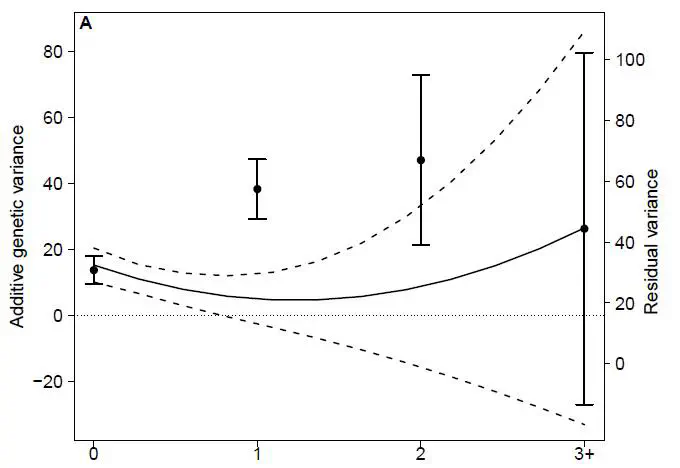 Additive genetic variance (solid line) and its 95% confidence interval (dashed lines) across ages. Dots and whiskers show the age‐ specific point estimates and 95% confidence intervals of residual variance (right axis).
Additive genetic variance (solid line) and its 95% confidence interval (dashed lines) across ages. Dots and whiskers show the age‐ specific point estimates and 95% confidence intervals of residual variance (right axis).Abstract
Animal personality traits are often heritable and plastic at the same time. Indeed, behaviors that reflect an individual’s personality can respond to environmental factors or change with age. To date, little is known regarding personality changes during a wild animals’ lifetime and even less about stability in heritability of behavior across ages. In this study, we investigated age‐related changes in the mean and in the additive genetic variance of exploratory behavior, a commonly used measure of animal personality, in a wild population of great tits. Heritability of exploration is reduced in adults compared to juveniles, with a low genetic correlation across these age classes. A random regression animal model confirmed the occurrence of genotype–age interactions (G×A) in exploration, causing a decrease in additive genetic variance before individuals become 1 year old, and a decline in cross‐age genetic correlations between young and increasingly old individuals. Of the few studies investigating G×A in behaviors, this study provides rare evidence for this phenomenon in an extensively studied behavior. We indeed demonstrate that heritability and cross‐age genetic correlations in this behavior are not stable over an individual’s lifetime, which can affect its potential response to selection. Because G×A is likely to be common in behaviors and have consequences for our understanding of the evolution of animal personality, more attention should be turned to this phenomenon in the future work.